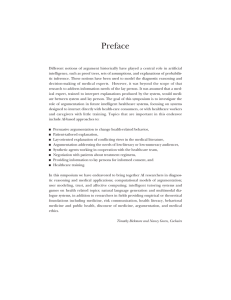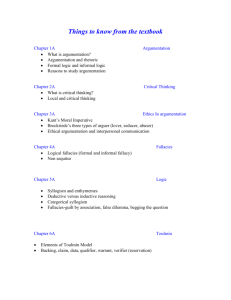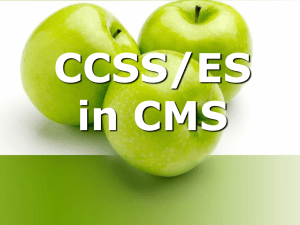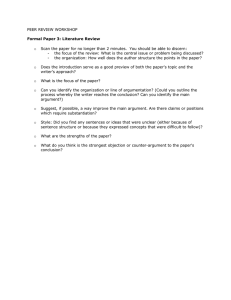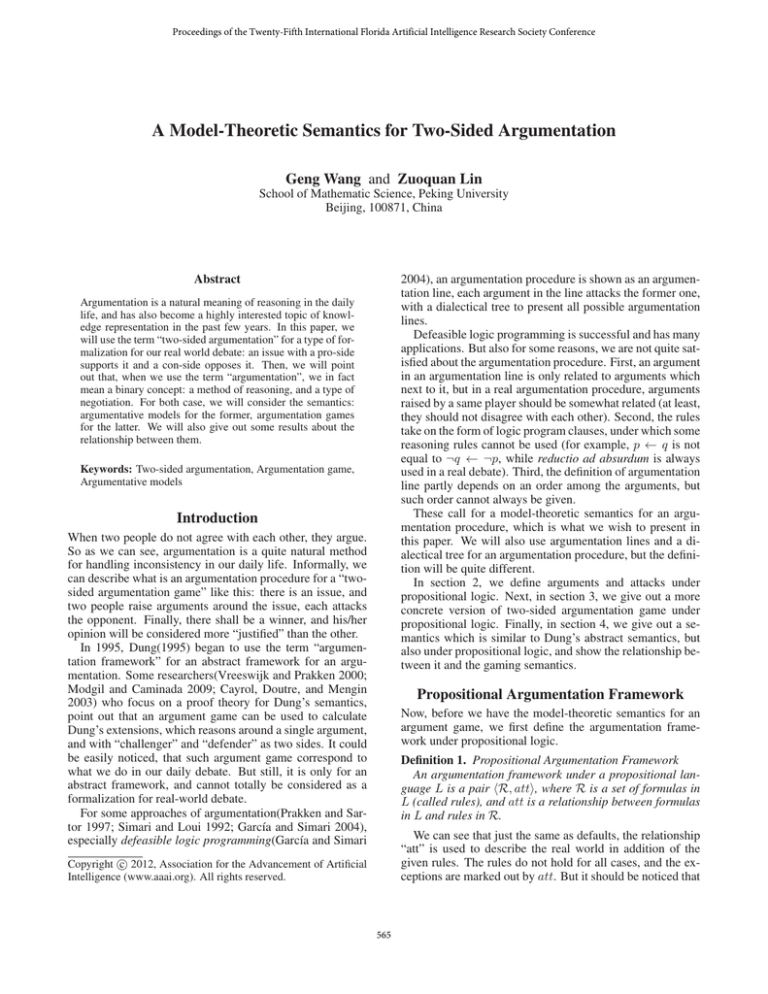
Proceedings of the Twenty-Fifth International Florida Artificial Intelligence Research Society Conference
A Model-Theoretic Semantics for Two-Sided Argumentation
Geng Wang and Zuoquan Lin
School of Mathematic Science, Peking University
Beijing, 100871, China
Abstract
2004), an argumentation procedure is shown as an argumentation line, each argument in the line attacks the former one,
with a dialectical tree to present all possible argumentation
lines.
Defeasible logic programming is successful and has many
applications. But also for some reasons, we are not quite satisfied about the argumentation procedure. First, an argument
in an argumentation line is only related to arguments which
next to it, but in a real argumentation procedure, arguments
raised by a same player should be somewhat related (at least,
they should not disagree with each other). Second, the rules
take on the form of logic program clauses, under which some
reasoning rules cannot be used (for example, p ← q is not
equal to ¬q ← ¬p, while reductio ad absurdum is always
used in a real debate). Third, the definition of argumentation
line partly depends on an order among the arguments, but
such order cannot always be given.
These call for a model-theoretic semantics for an argumentation procedure, which is what we wish to present in
this paper. We will also use argumentation lines and a dialectical tree for an argumentation procedure, but the definition will be quite different.
In section 2, we define arguments and attacks under
propositional logic. Next, in section 3, we give out a more
concrete version of two-sided argumentation game under
propositional logic. Finally, in section 4, we give out a semantics which is similar to Dung’s abstract semantics, but
also under propositional logic, and show the relationship between it and the gaming semantics.
Argumentation is a natural meaning of reasoning in the daily
life, and has also become a highly interested topic of knowledge representation in the past few years. In this paper, we
will use the term “two-sided argumentation” for a type of formalization for our real world debate: an issue with a pro-side
supports it and a con-side opposes it. Then, we will point
out that, when we use the term “argumentation”, we in fact
mean a binary concept: a method of reasoning, and a type of
negotiation. For both case, we will consider the semantics:
argumentative models for the former, argumentation games
for the latter. We will also give out some results about the
relationship between them.
Keywords: Two-sided argumentation, Argumentation game,
Argumentative models
Introduction
When two people do not agree with each other, they argue.
So as we can see, argumentation is a quite natural method
for handling inconsistency in our daily life. Informally, we
can describe what is an argumentation procedure for a “twosided argumentation game” like this: there is an issue, and
two people raise arguments around the issue, each attacks
the opponent. Finally, there shall be a winner, and his/her
opinion will be considered more “justified” than the other.
In 1995, Dung(1995) began to use the term “argumentation framework” for an abstract framework for an argumentation. Some researchers(Vreeswijk and Prakken 2000;
Modgil and Caminada 2009; Cayrol, Doutre, and Mengin
2003) who focus on a proof theory for Dung’s semantics,
point out that an argument game can be used to calculate
Dung’s extensions, which reasons around a single argument,
and with “challenger” and “defender” as two sides. It could
be easily noticed, that such argument game correspond to
what we do in our daily debate. But still, it is only for an
abstract framework, and cannot totally be considered as a
formalization for real-world debate.
For some approaches of argumentation(Prakken and Sartor 1997; Simari and Loui 1992; Garcı́a and Simari 2004),
especially defeasible logic programming(Garcı́a and Simari
Propositional Argumentation Framework
Now, before we have the model-theoretic semantics for an
argument game, we first define the argumentation framework under propositional logic.
Definition 1. Propositional Argumentation Framework
An argumentation framework under a propositional language L is a pair hR, atti, where R is a set of formulas in
L (called rules), and att is a relationship between formulas
in L and rules in R.
We can see that just the same as defaults, the relationship
“att” is used to describe the real world in addition of the
given rules. The rules do not hold for all cases, and the exceptions are marked out by att. But it should be noticed that
c 2012, Association for the Advancement of Artificial
Copyright Intelligence (www.aaai.org). All rights reserved.
565
Definition 5. (Argumentation Line)
Given a sequence of arguments A = [A1 , ..., An ], we use
P ri to note the presenter of Ai . P ri ∈ {P, C}, where P for
the pro-side and C for the con-side, P r1 = P , and P ri+1 6=
P ri .
For each i = 1, ..., n, the state of the (propositional)
argumentation
line is noted S
by hPi , Ci i, where Pi =
S
j≤i∧P rj =P R(Aj ) and Ci =
j≤i∧P rj =C R(Aj ).
Then, A is a legal argumentation line, if for each i:
1 If P ri = P and i > 1, I(Ai ) attacks Ci ; if P ri = C,
I(Ai ) attacks Pi ;
2 For each argument A, if P ri = P , R(A) ⊆ Ci and
I(A) attacks Pi , there is a formula f attacks R(A) which
Pi |= f ; and if P ri = C, R(A) ⊆ Pi and I(A) attacks Ci ,
there is a formula f attacks R(A) which Ci |= f ;
3 Pi 6|=AF ⊥ and Ci 6|=AF ⊥;
4 For every i, hPi , Ci i 6= hPi+1 , Ci+1 i.
We note I(A) = I(A1 ) as the issue of the argumentation
line.
An argumentation line [A1 , ..., An ] is maximal, if there is
no A which [A1 , ..., An , A] is a legal argumentation line.
In the definition above, (1) means that, each argument
must attack the opponent, so that all arguments in the line
would be related to the main issue. (2) means that, every player must defends him/herself against the opponent.
(3) means that, all rules holds by the same player must be
conflict-free. (4) means that, each time the player must raise
new arguments, so that when the rule base is finite, the argumentation line always ends.
We can see that, by the definition of states, we combine all
arguments raised by a same player as a whole, and each new
argument is related to the current state, not only one former
argument.
A maximal argumentation line describes a full argumentation procedure. By two ways an argumentation will ends,
one is falling into deadlock, the other is that one player be
unable to attack its opponent. It is also necessary that we
make difference between the two types of maximal argumentation lines.
Definition 6. A maximal argumentation line [A1 , ..., An ] is
E-type if there is no A which [A1 , ..., An , A] satisfies (1)-(3),
otherwise it is D-type.
A D-type argumentation line ends because if we allow a
player to raise an argument twice, the line will be infinite.
However, we still cannot determine the winner, so the argumentation ends with a draw. But in an E-type line, the
winner is the one who raised the last argument. To distinguish between the two types, we add a symbol D at the end
of a D-type line.
One may attach a partial order upon A to avoid cases of
draw, such as in (Martı́nez, Garcı́a, and Simari 2007). However, it makes the construction of argumentation lines extremely difficult, despite that such ordering cannot always
be given.
Definition 7. Dialectical Tree
With a given formula I, a dialectical tree around I is a
tree structure, its root node labeled by a special label RI ,
all other nodes labeled by an argument or D, which:
the semantics are totally different. In a default logic, if the
defaults do not hold, although the rule can no longer be used
for reasoning, it is not overthrown. In argumentation, however, if a rule is attacked, it cannot hold in the same model
with the attacker. We give out the semantics of a propositional argumentation framework by the definition below:
Definition 2. A model M is called compatible under a given
framework AF with respect to a set of rules R ⊆ R, if for
each (d, r) ∈ att and r ∈ R, M |= d and M |= r do not
hold at the same time. If R = R, we simply say M is a
compatible model under AF.
If all compatible models of Σ w.r.t R are models of p, we
call Σ implies p under AF w.r.t R, written by Σ |=AF (R) p.
If R = R, we simply say Σ implies p under AF and written
by Σ |=AF .
The relationship att only covers a small amount of attacks. It is natural that ¬r attacks r, and if d1 and d2 all
attack r, d1 ∨ d2 attacks r as well. In fact, as we used the
term compatible model to line out all conflicts, an attack can
be defined by: the attacker and the attacked arguments share
no common compatible models.
Definition 3. (Attack)
Under a given framework AF, we say a formula p attacks
a set of rules Σ ⊆ R, if Σ ∪ {p} |=AF (Σ) ⊥.
Now, with the given framework, we can talk about an argument under propositional language.
Definition 4. (Argument)
An argument of a given framework AF is a pair A =
hΣ, pi, where:
1 Σ 6|=AF ⊥.
2 Σ |= p.
3 Σ is a minimal subset of R satisfies 1 and 2.
p is called the issue of the argument (noted by I(A)), and
Σ is called the support rules (noted by R(A)).
If p attacks a set of rules R0 , we say A attacks R0 , and if
0
R = R(A0 ), we say A attacks A0 .
Although our relationship “attack” is an issue attacks one
or some of the rules, but it can also be extended to attacks
between arguments, since the issue can represents an argument, and the rules are those which support an argument.
Thus, our framework can be viewed as an instantiation of
abstract framework.
Example 1. Let A1 = h{a, a → c}, ci, and A2 = h{b, b →
¬c}, ¬ci. Then A1 and A2 attack each other. Furthermore,
if there is A3 = h{d}, di, and (d, a → c) ∈ att, then A3 is
an attack to A1 .
Propositional Argumentation Games
The definition of argumentation procedure might be more
complicated than what is under abstract framework. For example, if R(C) ⊆ R(A)∪R(B), and the pro-side has both A
and B in its acceptable set, it must also have C in its acceptable set. Besnard and Hunter(2001) discussed such cases
in the means of syntax, but we wish to consider it from a
semantics way.
566
sure which model shows the truth, and whether the justified
result is reasonable.
This enlightened us to restrict all arguments raised by the
same player within a single model, so that there will be no
conflicts between them. This is what we will discuss in the
next section.
1 The label of each path in the tree (from root to one of the
leaves) except the root forms a maximal argumentation line
around I (D-type if the last label is D, E-type otherwise);
2 Each maximal argumentation line around I can be expressed by labels of a path in the tree.
We show the presenter of an argument by labeling the
level of the tree from {P, C}: level 0 (the root level) is labeled by C, and level i + 1 with a label different by level
i.
Argumentative Model
To restrict an argumentation game with a model, first, as the
definition of legal argumentation lines, we shall define an
argument induced from a model. To make it short, when we
mention a model below, it means a model that is compatible
under the given framework.
Definition 8. An argument hΣ, pi is induced from a model
M , if for every r ∈ Σ, M |= r.
Now, we can talk about the idea of argumentative models.
Definition 9. (Argumentative Models)
If for any argument A, either M |= I(A) or there is an
argument A0 induced from M which A0 attacks A, we call
that M is a positive model under the framework.
If for any argument A induced from M and an argument
A0 attacks A, there is an argument A00 induced from M
which A00 attacks A0 , we call that M is a defensive model.
Of course, all positive models are defensive models, but
not vice versa.
Theorem 1. Let M be a compatible model under a framework (R, att), and R1 = {r|r ∈ R ∧ M |= r}, R2 =
{r|r ∈ R ∧ M 6|= r}.
Then M is a positiveWmodel iff for each r ∈ R2 , D =
{d|(d, r) ∈ att}, R1 |= D ∨ ¬r.
Referred to Dung’s semantics for abstract framework(1993), if we view a model as the set of all arguments
induced from the model, we can see that a positive model
corresponds with a stable extension, and a defensive model
corresponds with a preferred extension.
Argumentative models are partly related to argumentation
games in the previous chapter, just as the theorem below:
Theorem 2. Let p be true under a positive model M . The
pro-side cannot win an argumentation game around ¬p.
Let p be true under a defensive model M , and there is
at least one argument A induced from M which I(A) = p.
Then the con-side cannot win an argumentation around p.
Theorem 3. Let p be an arbitrary formula. If p is justified,
then for all positive models M , p is true under M .
Note that although we haven’t mentioned the condition
“two-player” in our discussion of argumentative model, it
still cannot be ignored. If an argumentation has more players, there might be difference. Give an example.
Example 3. The framework is h{a, b, c}, {(b, a), (c, b),
(a, c)}i. It is clear that there are neither positive models nor defensive models under the framework. However,
when there are three players, named A, B, C, who raise
only arguments h{a}, ai, h{b}, bi, h{c}, ci each, the argumentation game will comes into a deadlock. So models
{a, ¬b, ¬c}, {¬a, b, ¬c}, {¬a, ¬b, c} are all “positive” under the condition of three players.
In order to determine which side has a winning strategy,
we can label nodes in the tree with an additional symbol
P , C or D, which represent the pro-side wins, the con-side
wins, and the game draws.
The additional labels are given from leaves to root by:
1 For each leaf node, if it is D, it is labeled by D, otherwise, it is labeled by the label of its level.
2 Given an order P > D > C. If a node is on a level
labeled by P , it is labeled by the minimal label of its subnodes. If a node is on a level labeled by C, it is labeled by
the maximal label of its sub-nodes.
It is easy to see, if the root is labeled by P , the pro-side
can choose each time on his/her turn a node labeled by P
to form a winning argumentation line, and we say that the
pro-side wins the game, or the issue is justified. If the label
is C, the con-side wins, and the issue is overthrown. If the
label is D, neither side can win, and the game draws.
We can see that the pro-side always hold the issue, and
the con-side always oppose it. We will give an example of
an argumentation game.
Example 2. Back to the example above. Suppose we had list
out all rules and attacks in the given framework. Consider
an argumentation around I. We can see that [A1 , A2 , D]
is a D-type argumentation line, while [A1 , A3 ] is a E-type
argumentation line. It is easy to see that the con-side wins
the game.
If the argumentation is around ¬I, [A2 , A1 , D] and
[A2 , A1 , A3 ] are both maximal argumentation lines, and the
pro-side can win the argumentation.
Figure 1: An example of proposition dialectical tree
Such idea of justifying an issue is quite fit for simulating
a real world debate. However, a real world debate does not
always get a more reliable result.
Suppose an issue is justified, so each path (also an argumentation line) in the tree which P is the winner corresponds to a model set M od(Pi ). However, if there is no
common model among all these model sets, we cannot be
567
The two-sided argumentation we discuss about has its
limits also. There are lots of discussions around the “odd
loop problem” of Dung’s framework, and lots of researchers
seek to improve. In this paper, however, we showed that
the problem occurs because Dung’s semantics only fits twoplayer argumentation. The semantics of arbitrary n-player
argumentation has still a lot to learn about.
Argumentation has been discussed for thousands of years,
and there are many useful results. To completely formalize
argumentation in logic, there is still a long way to go.
This is the problem of “odd-length cycles”(Baroni and Giacomin 2003) in Dung’s abstract framework. We can see,
why such problem occurs, is that such semantics are only
suitable for an argumentation with two players.
Related Works
We use argumentation lines and dialectical trees to define
and calculate whether an issue can be justified. Similar
definitions can also be found in (Simari and Loui 1992;
Garcı́a and Simari 2004; Besnard and Hunter 2001). However, our definition of argumentation line is totally different
from others. In other definitions of argumentation line, an
argument in the line is only related to the one right next to
it. Although the difference between pro-side arguments and
con-side arguments was mentioned, all pro-side arguments
or all con-side arguments are not considered as a whole.
When we take it back into real-world debates, where an argument is always used to defeat some of the opponent’s arguments combined, such approaches are not-so-acceptable.
By using the concept argumentation states in our definition
of argumentation lines, we handle such cases more correctly.
Also, with the definition of states, we can define draws more
precisely, not by arbitrarily cutting down the argumentation
line to prevent infinity.
We have mentioned above, that our framework is a instantiation of Dung’s framework(1993), and our argumentative
models correspond with Dung’s extensions. But it should
be noticed that since we define our semantics under propositional logic, we avoided some trouble when using Dung’s
framework. We give an example in our framework which is
similar to one presented by (Caminada and Amgoud 2007):
References
Baroni, P., and Giacomin, M. 2003. Solving semantics problems with odd-length cycles in argumentation. In Proc. of
ECSQARU’03, volume 2711, 440–451. LNAI.
Besnard, P., and Hunter, A. 2001. A logic-based theory of
deductive arguments. Artificial Intelligence 128(1-2):203–
235.
Caminada, M., and Amgoud, L. 2007. On the evaluation
of argumentation formalisms. Artificial Intelligence 171(56):286–310.
Cayrol, C.; Doutre, S.; and Mengin, J. 2003. On decision problems related to the preferred semantics for argumentation frameworks. Journal of Logic and Computation
13(3):377–403.
Dung, P. 1993. On the acceptability of arguments and its
fundamental role in nonmonotonic reasoning and logic programming. In Proc. of the 13th IJCAI. Chamber, France.
Dung, P. 1995. On the acceptability of arguments and
its fundamental role in nonmonotonic reasoning, logic programming and n-person games. Artificial Intelligence
77(2):321–357.
Garcı́a, A., and Simari, G. 2004. Defeasible logic programming: An argumentative approach. Theory and Practice of
Logic Programming 4(1):95–138.
Martı́nez, D.; Garcı́a, A.; and Simari, G. 2007. Modelling
well-structured argumentation lines. In Proc. of IJCAI’07,
465–470.
Modgil, S., and Caminada, M. 2009. Proof theories and
algorithms for abstract argumentation frameworks. In Rahwan, I., and Simari, G., eds., Argumentation in AI. SpringerVerlag. 105–132.
Prakken, H., and Sartor, G. 1997. Argument-based extended
logic programming with defeasible priorities. Journal of Applied Non-Classical Logics 7:25–75.
Prakken, H. 2005. Coherence and flexibility in dialogue
games for argumentation. Journal of Logic and Computation 1009–1040.
Simari, G., and Loui, R. 1992. A mathematical treatment
of defeasible reasoning and its implementation. Artificial
Intelligence 53:152–157.
Vreeswijk, G., and Prakken, H. 2000. Credulous and
sceptical argument games for preferred semantics. In Proc.
7th European Workshop on Logic for Artificial Intelligence,
239–253.
Example 4. Let A = h{a, d, c, a → b, d → e}, {(c, b∧e)}i,
and A1 = h{a, a → b}, bi, A2 = h{d, d → e}, ei, A3 =
h{c}, ci.
If we consider A1 , A2 , A3 as abstract arguments in
Dung’s abstract framework, they all have no defeaters, thus
b, e, c are all justified. However, c attacks b ∧ e.
Our formalization also shares much similarity
with dialogue games for argumentation discussed by
Prakken(2005). Multi-replies and non-immediate replies
had also been included under his framework. However, as it
is a framework with variable degrees of flexibility, it is not
totally logical and without semantics.
Conclusion and Future Work
In this paper, we define an argumentation framework under
propositional logic, and use it on the special case of twosided argumentation. We then describe the argumentation
procedure in two different ways, as argumentation games
and as (positive or defensive) models. Although these are
different approaches, they are related to each other, and the
goal is the same: formalize real world argumentation, and
use it for reasoning.
Because our definition of arguments is far from syntax,
the problem of generating proper arguments in an dialectical
tree is rather complicated. We are still working on to find an
efficient algorithm for such problem.
568


